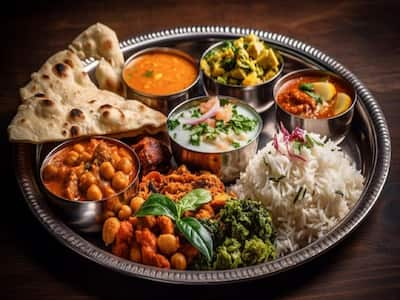
Nutritionist Dr. Meghana Pasi shares some tips to make home cooked food healthier.
When was the last time you actually relished every morsel of food that was served on your plate? It is a very common sight to see people eating while watching TV, having lunch during a team call or while driving and not actually enjoying the food. When there is no mind-body-food connection, you may not feel good and contented after eating, which can result in overindulgence, frequent cravings and binge eating. The major cause for the rise in non-communicable diseases like diabetes, cancer and heart diseases, is unhealthy eating. And one important reason for unhealthy eating practice is increase in consumption of outside (restaurant food) and processed ready-to-eat food. More people now do not prefer to cook at home, thinking it is cumbersome and time consuming. But if you want to improve your health and maintain healthy weight, one of the simplest things you can do is to have more home-cooked meals.
Dr. Meghana Pasi, Nutrition Consultant, MyThali Program, ArogyaWorld, tells you some amazing health benefits of cooking at home and how to make daily meals healthier.
Benefits of having home cooked meals
There are numerous benefits of having home food such as:
- You are aware of the ingredients (raw vegetables, grains, spices, oil, salt etc.) that go into a dish prepared at home and hence you can be sure of its quality and portion size.
- Restaurant foods are often loaded with fats, salt, sugar and other additives, making them calorie dense and less nutritious. Whereas the same dishes prepared at home can be made more nutritious and lower in calories.
- You can maintain hygiene and quality of the food, thus helping reduce the risk of allergies and food borne illnesses.
Be it a Bengali fish meal, a Maharashtrian sol kadhi meal, a Punjabi rajma-chawal meal or a south Indian rasam-rice meal; a thali from any region can become a delicious healthy meal when prepared with a combination of different food groups in the right portion sizes.
How to make home-cooked meals healthier
Dr. Meghana encourages people to be mindful about certain things while preparing any Thali or a meal at home, which are:
1. Including all four food groups on the plate in the right portion sizes.
- Cereals/grains: For example, rice, chapati, pulao, paratha, rotla, mudde, pasta, and noodles are great sources of carbohydrates and fiber.
- Pulses/dals/meat/egg/fish:Rajma, chole, tur dal, udad dal, mung, sprouts, soyabean, chicken, egg, and fish are rich sources of proteins.
- Vegetables: Sagu, palya, bhaji, sabji, salad, koshimbir, saag, curries, gravies, kormas, etc. A seasonal vegetable can give the required vitamins, minerals and fiber.
- Milk product/dairy: Raita, curd, mishti doi, buttermilk, paneer. All these contain proteins, calcium, probiotics and support digestion.
2. Using fresh, healthy ingredientsand keeping your meals simple
READ RELATED: McDonald's Just Started Serving a Striking Dessert You've Never Seen Before
- Simple cooking can be tasty and quick. Mix-vegetable khichdi, pulao, rajma-rice with curd, paneer wrap with boiled channa and lassi, pasta with paneer salad and curd. These are all great meals for a soul-filling healthy lunch.
- Try steaming, sauteing and grilling instead of deep frying to reduce loss of nutrients.
- Use lemon and herbs to reduce your sodium intake.
- Limit use of added sugar by replacing it with substitutes like fruit pulps, dry fruits, figs and dates.
- Do not reuse oil which has been earlier used for frying. This can help in reducing trans fats in your diet. Choose healthy fats like olive oil, mustard oil, groundnut oil, fish, walnuts, flax seeds over processed meat, butter and cheese.
- Choose pasta and bread made of whole grain versions instead of refined wheat.
3. Incorporating our age-old fit food hacks
- You may add a teaspoon of ghee over chapatis, in dal/rice to get more Vit. A and antioxidants.
- Have a glass of Haldiwala dudh (turmeric and black pepper milk) to boost your immune system.
- Include idli, dosa, dhokla, appam, buttermilk, kanji, pickles in your daily meals. These traditional foods contain a good amount of probiotics can keep your gut healthy.
- Add spices like pepper, ginger, garlic, cumin, cloves, fenugreek seeds, turmeric to your everyday foods. These spices carry chemical compounds which have antibacterial, antifungal, antimicrobial and antiviral properties which help fight several kinds of infections.
4. Keeping healthy ready-to-eat munchies on your dining table
For example, roasted chana, peanuts, fruits, tender coconut, nuts, seeds, chikki, makhana, peanut butter and dates. are good options as they are extremely nutritious.
Total Wellness is now just a click away.
Follow us on
Don’t Miss Out on the Latest Updates.
Subscribe to Our Newsletter Today!
window.addEventListener(‘load’, (event) => {
$(‘#commentbtn’).on(“click”,function(){
(function(d, s, id) { var js, fjs = d.getElementsByTagName(s)[0]; if (d.getElementById(id)) return; js = d.createElement(s); js.id = id; js.src = “//connect.facebook.net/en_US/sdk.js#xfbml=1&version=v2.3”; fjs.parentNode.insertBefore(js, fjs);}(document, ‘script’, ‘facebook-jssdk’));
$(“.cmntbox”).toggle();
});
});








